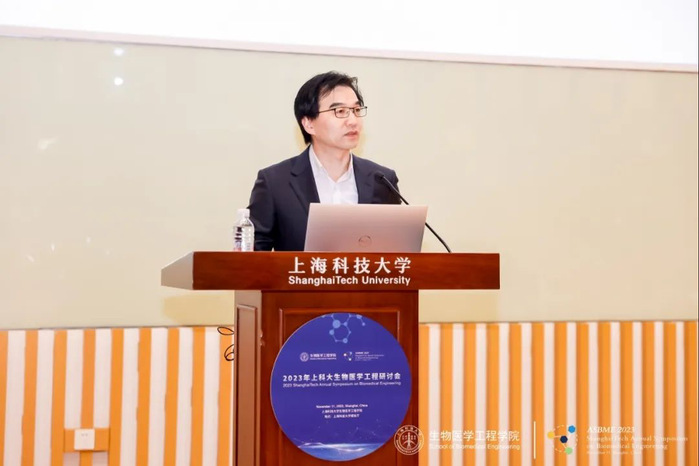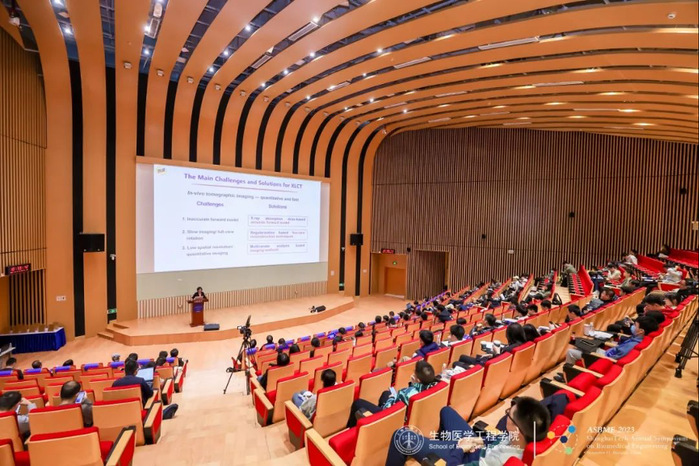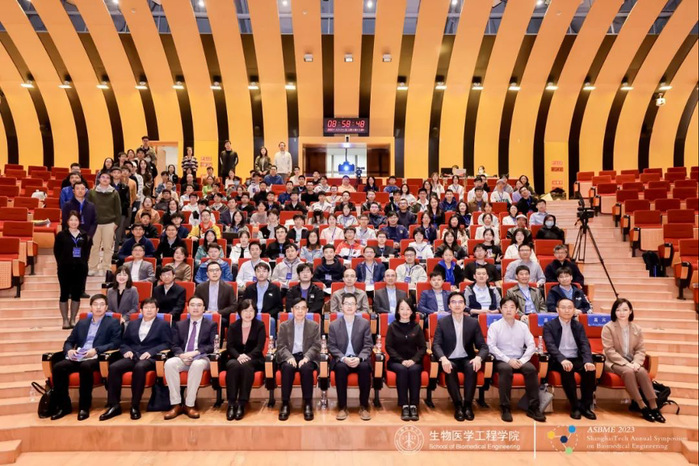The 2023 ShanghaiTech Annual Symposium on Biomedical Engineering (ASBME 2023) was held in the University Auditorium on November 11. The symposium aims to promote extensive exchanges about the latest academic achievements in biomedical engineering and to explore the future direction of the discipline and transfer prospects.
Twelve well-known scholars from the field of biomedical engineering were invited to give talks at the symposium, which attracted more than 200 guests from universities, research institutes, hospitals and industries to gather together and discuss the monitoring, diagnosis and treatment of major diseases. The symposium was broadcast on live video and picture relay, with more than 40,000 people watching online. The opening ceremony was hosted by Hu Peng, Chairman of the Organizing Committee and Executive Dean of BME.
In his opening speech, Li Ruxin, Vice President of ShanghaiTech, took, as an example, the attosecond light pulse technology studied by three Nobel Prize winners in 2023.
This technology, which employs a method of capturing the high-speed movement of electrons for the precise diagnosis of diseases, shows the great potential of biomedical engineering for diagnosis and treatment.

He also reviewed the ten-year development of the university’s biological and engineering disciplines and indicated that he expected BME to bring new vigor to the innovative spirit of ShanghaiTech.

Shen Dinggang, Chairman of the Symposium and Founding Dean of BME, introduced the school’s history and development to the attendees.

The symposiumsessions focused on four major areas: “Precision Medicine”, “Integrated Diagnosis and Treatment”, “Medical Imaging” and “Innovative Systems and Imaging Methods”, and showcased the latest progress in biomedical engineering through keynote speeches. All thespeechescentered on the theme of “Healthy China”, which cannot be achieved without science and technology. Improving medical standards and protecting public health is a time-consuming and challenging task. Toboost the sustainable development of biomedical engineering, it is necessary to keep an open, innovative and cooperative mind. This was also the original intention of ShanghaiTech in holding this symposium.
In the “Precision Medicine” session, the speechesconcentrated on the use of imaging technology, digitalization, and drug delivery to create new treatments and improve the accuracy of diagnosis and treatment.
The “Integrated Diagnosis and Treatment” session explored how to solve medical problems through advanced imaging technology and precise algorithms, which reflects the close relationship between biomedical engineering and clinics.
In the “Medical Imaging” session, the speechescalled for expanding and deepening the clinical application of advanced imaging technology and accelerating the clinical transfer of medical imaging technology.
The “Innovative Systems and Imaging Methods” sessionlooked into the promising future of innovative wearable devices and imaging technologies in advancing the clinical transfer of research findings.
The attending expertsshared theirprofessional perspectives, arousing heated discussions and in-depth thinking about tech transfer among the participants.
This conference provides a good platform for clinical transfer research and technological innovation, and creates opportunities for participants to exchange ideas. At the same time, the record-high number of offline and online participants demonstrates the improvement of the school’s influence in the field of biomedical engineering. The school will continue to move towards the goal of building a nationally top and world-class biomedical engineering discipline.

So far, the school has been approved for two major projectsin the China Brain Projectand, jointly with United Imaging, has built a high-level platform for medical equipment innovation. It also cooperates closely with the Shanghai Clinical Research and Trial Center to serve the national and Shanghaidevelopment strategiesfor economic development.

